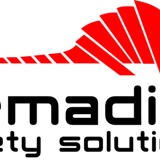Title Page
-
Document No.
-
Audit Title
-
Client / Site
-
Conducted on
-
Prepared by
-
Location
-
Personnel
Safety markings
-
European conformity mark (CE mark) applied to significant parts of the machine?
-
The CE marking covers the whole machine integration?
Safety zones
-
The working area is clearly identified or marked?
-
Is of adequate size to give warning to pedestrians of the dangers in the working zone?
-
Identifies specific hazards through signage?
Fixed guards
-
Perimeter guarding is of robust construction?
-
Fixed guards are of robust construction, not bend or damaged so as to present a hazard?
-
Close guarding is used instead or as well as perimeter guards where persons can interact with powered moving machinery?
-
Guarding has adequate number of fixings to be effective and all fixings are in place and secure?
-
Parts of machinery or components are guarded to prevent contact burns or scalds?
-
Guarding will contain ejected material from bursts, shattering or disintegration?
Access / Egress
-
There is a clear access route in to the working zone?
-
There is good visibility into the working area?
-
Where perimeter guarding is used, there is more than 1 entry point to facilitate rescue or rescue arrangements are in place?
-
Access is through a controlled system such as fortress keys
Interlock guards
-
Interlock guard is used where frequent access is needed?
-
The guard totally encloses the dangerous components ?
-
Interlock switches are not easily defeated and fail to safe if circuit is interrupted?
-
The guard prevents the machine from operating unless the guard is fully closed?
-
Any powered motion is stopped when the guard is opened before a person can touch the moving parts?
-
Interlock switches are in good condition, a process of checking is in place and checks carried out before use or at regular intervals?
Two handed controls
-
Requires simultaneous operation within 0.5 seconds by both hands?
-
Controls shrouded to prevents them being spanned by one hand, arm or bar placed across them?
-
Controls must be released and spring back before another cycle can be initiated?
-
Powered motion stops if one or both buttons are released?
-
Buttons are of sufficient distance away so that the danger point can not be reached before the movement has stopped?
-
Buttons are located to limit accidental damage, are in a comfortable position for the operator and can be operated with low force?
-
Additional types of guard are used where there is a risk of access to moving machinery by those other than the operator?
Automatic guards
-
On push guards the top bar is never less than 1070mm above the standing position of the operator
-
There are no trapping points created between the moving guard and any other part of the machine or surrounding equipment
-
There are no loose, missing, bent or unduly worn guard parts, guard are securely fixed
-
Access is prevented from beneath the guard when it is in motion by a suitable screen or additional guarding
Photo electric devices
-
Set in position to ensure no part of a persons body can access the danger area before activation?
-
Secure in position, undamaged and protected?
-
Causes machinery to stop or take up a safe position when activated?
-
Does not allow any blind spots behind the guard allowing a reset whilst a person is in the danger zone?
Emergency stops
-
Provided where it is reasonably foreseeable that operators could be exposed to danger?
-
Can be easily reached and activated from the positions where operators are expected to work?
-
Disrupts circuitry such that activation of machinery can not occur unless it is reset?
Safe setting
-
Safe setting mode provide minimum movement, manual inching, slow speed or reduced power to perform set up tasks?
Machinery protection
-
Safety critical components are guarded or located to prevent damage during operation and maintenance?
-
Machinery can not be easily interfered with or adjusted by operators in a way to make it unsafe?
-
Machine or its components are stable or secured so not to move under minor impact or vibration?
-
Is a lock out / tag out system in place?
Energy sources
-
Is there a means to switch off electrical, hydraulic or pneumatic power?
-
Is there a means to lock off / tag off sources of power?
-
Is the equipment available to enable a lock out / tag out system?
-
Mechanical or physical restraints are available to prevent machinery creep through gravity?
-
There is a means to depressurise / release energy for maintenance or emergency?
Electrical protection
-
Electrical connectors and live components are suitably screened inside cabinets or protected with finger guards to prevent accidental contact?
-
Risk of electrocution is minimised through use of RCD's or reduced voltage?
-
Electrical components and connections are suitably double insulated and earthed?
Housekeeping
-
Racking or storage is available for tools and components ?
-
Waste bins are appropriately placed and suitable for waste streams generated?
-
The floor is in good condition and free from hazards as to prevent trips?
Fire specific
-
Motors are operating within normal parameters (around 80 degrees C)?
-
Motors and electrical supply boxes are earth bonded?
-
Extraction motors and ducting are free from excessive oil and grease contamination?
-
Heat and ignition sources are at least 1 meter away from any fuels or combustibles?
-
Running temperatures do not exceed the flash point of oils and lubricants used.
Environment
-
There is sufficient lighting, heating, cooling and space to operate the machinery safely?
-
The machinery is protected from the weather or designed to operate in the weather conditions?
General risk assessment
-
A general risk assessment has been completed for the area of operation?
-
A detailed PUWER assessment has been carried out on the equipment?












